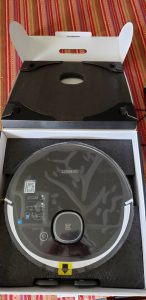My membership warehouse company, Costco, sells both the iRobot models but also the Ecovacs brand. I was intrigued so I brought home the Ecovacs Deebot Orzo 920. What do I have to lose, with Costco’s generous return policy protecting me? I ordered the Orzo 920 online and waited patiently for it to arrive.
The Orzo 920 is almost perfect as far as robot vacuums go, though I’m not sure why is has such a long name (how many brand names does one robot need?). A Chinese model, it nevertheless has clearly-written documentation and labels. The box contained the robot, charging dock, booklet, two HEPA filters and a tool for cleaning the brushes. Instinctively I set up the charging dock and put the robot on it, not realizing I had to flip the red switch on top to actually turn it on.
Modern robot vacuums need Internet access, so I had to go through steps to connect it to my home network. I downloaded the Evovacs app for my Android phone and set the vacuum up to advertise its WiFi signal. Connecting it to the app was simple and quick.
Once the Orzo was charged, I used the app to set it up. The Orzo uses LIDAR laser ranging to map the floors of your home. It maps your home the first time it’s run, after which you can edit the map to divide areas, mark off spots with “virtual boundaries,” and make other adjustments. Different advanced vacuums use different technologies to map rooms (iRobots use a visual camera) but in my experience the LIDAR is tough to beat. It was a treat to watch as the app filled in walls as the robot proceeded around the room. It does an amazingly accurate job figuring out where it is and what the room looks like. I could tell this was not a robot that would ever get lost on the way back to the dock.
One thing I learned right away is that the initial mapping takes longer than a normal cleaning. This may just be my experience but I wanted it to be thorough in its mapping at the expense of deep cleaning the first time. I discovered an option in the app’s settings which allows you to set the vacuum’s power on the “Quiet” setting. This uses far less battery than the normal power modes so I was able to get the vacuum to completely map my floor without having to stop and charge mid-way.
Multiple floors are supported, so once the Orzo had mapped the downstairs I moved the dock and vacuum upstairs and had the Orzo map it, too. Only two maps seem to be in the app so if your home has more than two you might be out of luck.
Continue reading




